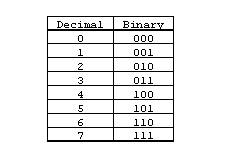Binary Numbers and Binary Math
The binary number system is an alternative to the decimal (10-base) number system that we use every day. Binary numbers are important because using them instead of the decimal system simplifies the design of computers and related technologies. The simplest definition of the binary number system is a system of numbering that uses only two digits—0 and 1—to represent numbers, instead of using the digits 1 through 9 plus 0 to represent numbers.
To translate between decimal numbers and binary numbers, you can use a chart like the one to the left. Notice how 0 and 1 are the same in either system, but starting at 2, things change. For example, decimal 2 looks like 10 in the binary system. The 0 equals zero as you would expect, but the 1 actually represents 2. Here’s how to translate between binary and digital. In every binary number, the first digit starting from the right side can equal 0 or 1. But if the second digit is 1, then it represents the number 2. If it is 0, then it is just 0. The third digit can equal 4 or 0. The fourth digit can equal 8 or 0. And so on. If you write down the decimal values of each of the digits and then add them up, you have the decimal value of the binary number. In the case of binary 11, there is a 1 in the first position, which equals 1 and then another 1 in the second position, so that equals 2. Add 2 + 1 together and you get 3.
As numbers get larger, new digits are added to the left. To determine the value of a digit, count the number of digits to the left of it, and multiply that number times 2. For example, for the digital number 100, to determine the value of the 1, count the number of digits to the left of the 1 and multiply that number times 2. The number is 2 × 2, which equals 4. The total value of binary 100 is 4, since the numbers to the left of the 1 are both 0s. Now you know how to count digital numbers, but how do you add and subtract them? Binary math is similar to decimal math. Adding binary numbers looks like that in the box to the right above.
To add these binary numbers, do this: Start from the right side, just as in ordinary math. In the column of numbers on the far right side, add 0 + 1 as you would normally to get 1. Write a 1 down in the solution area. But in the second column, 1 + 1 doesn’t equal 2, it equals binary 2, which is written 10. Any time you add 1 + 1 in binary math, write down a 0 and carry the 1 to the next column. In the third column, you now have 0 + 1 plus the 1 you carried over. According to our rule, that equals 0, so write 0 and carry the 1 to the next column. Now in the fourth column you have 1 + 1, + the 1 you carried over. Any time you have a column that adds up to decimal 3, you write down a 1 in the solution area and carry a 1. In the fifth column you have only the 1 that you carried over, so you write down 1 in the fifth column of the solution. The same problem in decimal math is 10 + 15 = 25.
Computers rely on binary numbers and binary math because it greatly simplifies their tasks. Since there are only two possibilities (0 and 1) for each digit rather than 10, it is easier to store or manipulate the numbers. A simple device like a switch or a transistor that has two distinct states, like “on” and “off,” can become a number storage unit or part of a calculator. Computers need a large number of transistors to accomplish all this, but it is still easier and less expensive to do things with binary numbers rather than decimal numbers.
The original computers were used primarily as calculators, but later they were used to manipulate other forms of information, such as words and pictures. In each case, engineers and programmers sat down and decided how they were going to represent a new type of information in binary form. The chart shows the most popular way to translate the alphabet into binary numbers (only the first six letters are shown). It is called the American Standard Code for Information Interchange or ASCII.
Although it is pretty complicated to do so, sounds and pictures can also be converted into binary numbers, too. They have to be divided up into small elements (“samples” in audio or “pixels” for pictures), and then every element has to be assigned a number. The result is a huge array of binary numbers, and the volume of all this data is one reason why image files on a computer are so large, and why it is relatively slow to view video or download audio over an internet connection.
Binary represented as words
With 8 bit binary, eg 1010 or 1101 etc, many logic and protocol analysers and Binary Editors will show these sequences as hex “AA” or “B1” respectively. [ 10=A] and [11=B]. A familiar binary code sequence to is 0711, represented as “7E” also having the ASCII representation of a full stop “.” This 7E word is also the end of sequence terminator for Extended Binary Coded Decimal Interchange Code (EBCDIC) data sequences – drawing a neat transition between English grammar and computer data sequences.

